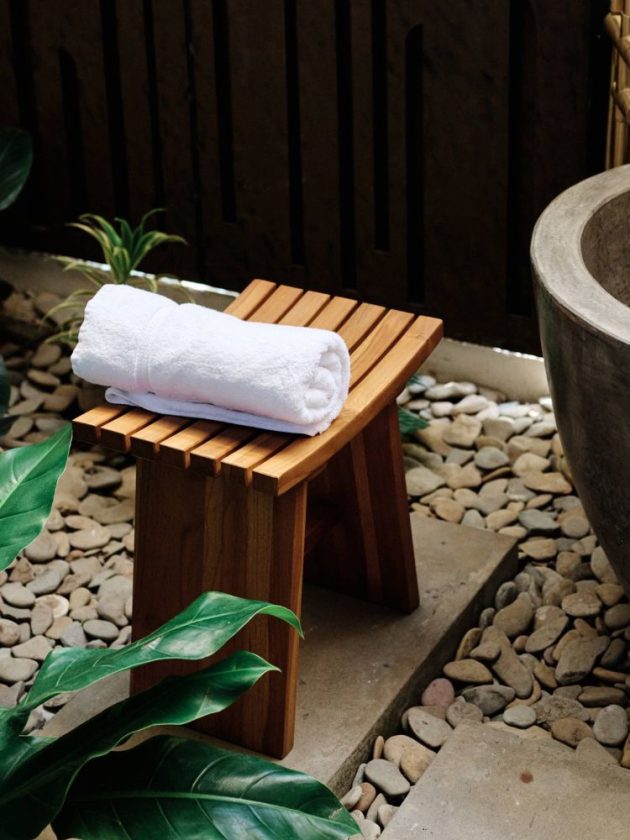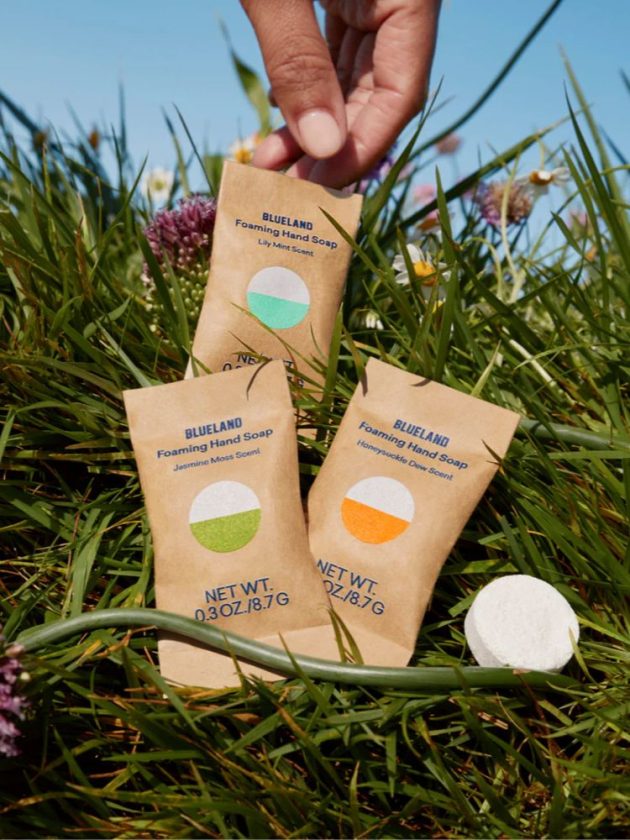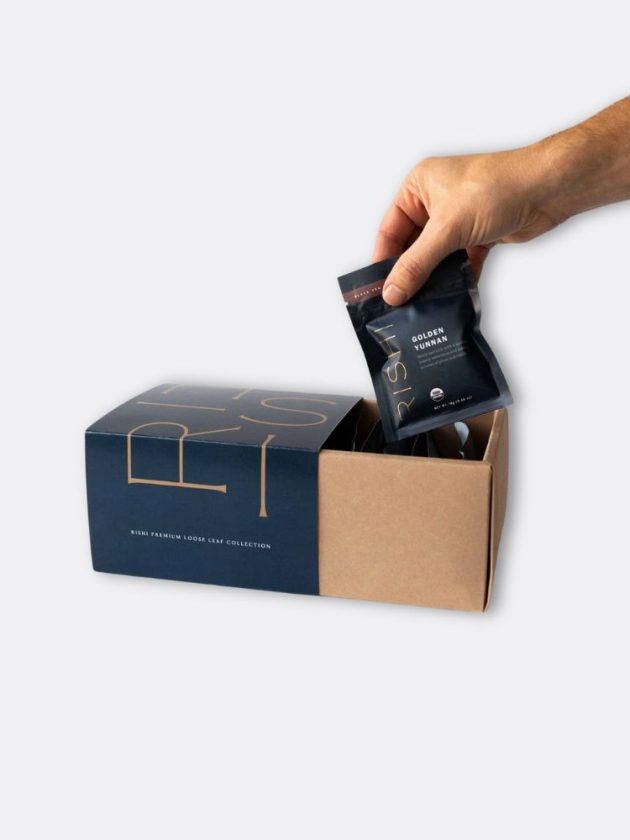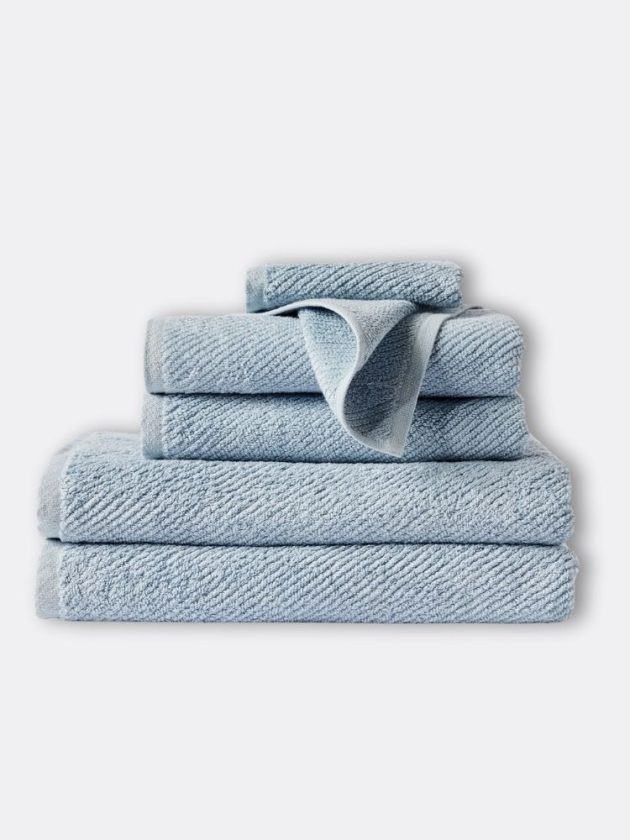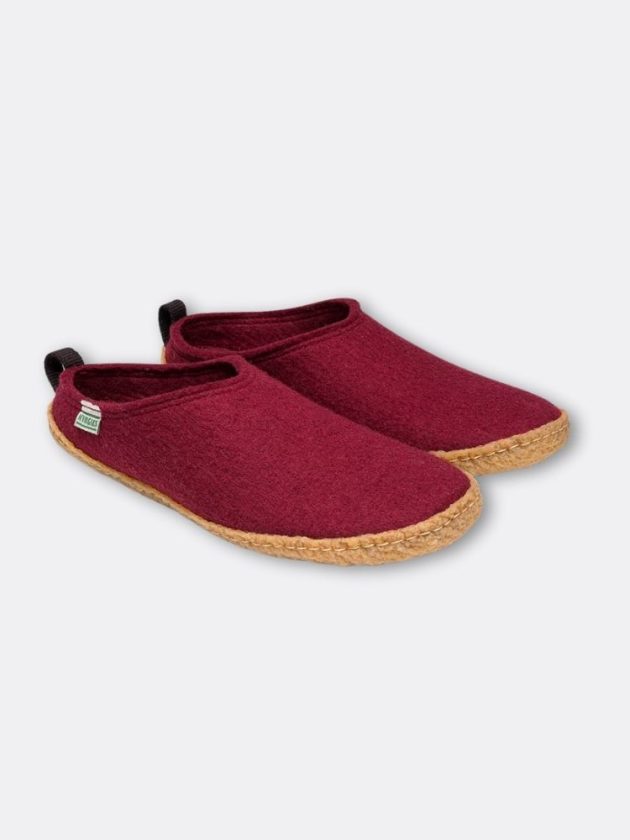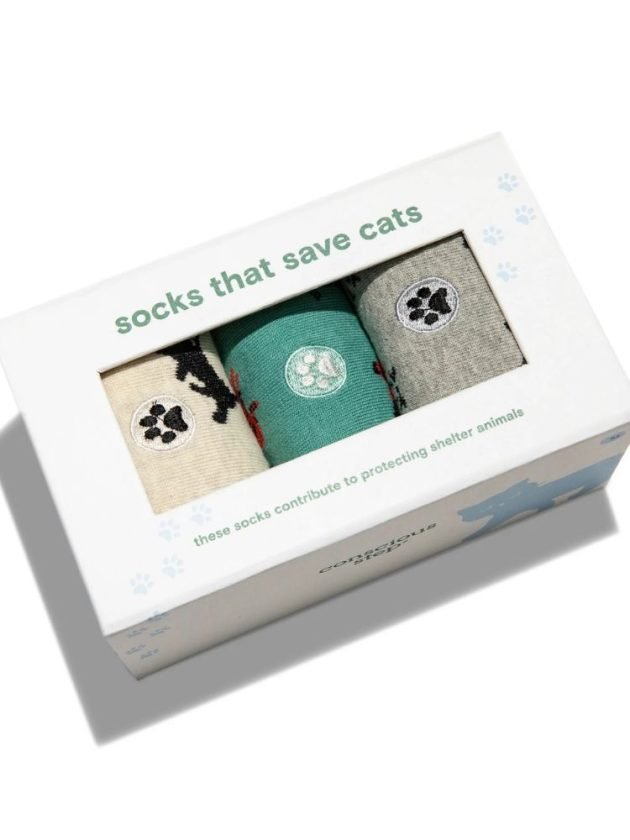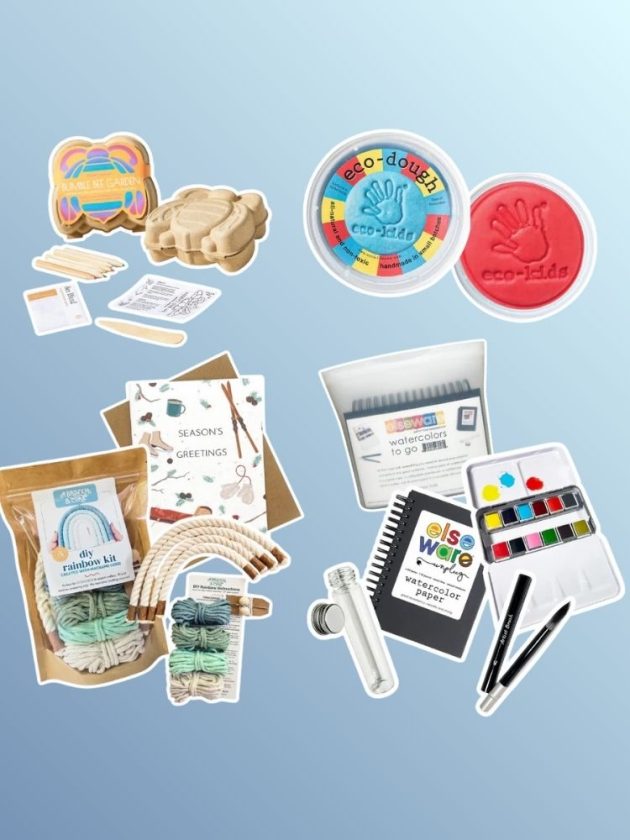Jean-Marc Jancovici is a well-known lecturer in France, and on YouTube, on the topics of energy and climate change. He focuses on the deep history and interconnections of the Earth’s consumption apparatus – how things are made, what things are made of, how energy is created, distributed and burned, and how the energy needs of the future should be met.
Christophe Blain is a French graphic artist known for his humorous historical works, most notably Weapons of Mass Diplomacy. But a few years ago, he was struck by current events in his home country.
“In the summer of 2018, there were severe heat waves,” Blain said. “I realized they were linked to global warming. I said to myself, ‘This is it, we’re here.’ I was very anxious for a year.”
He began talking to his brother to see what could be done. His brother had been following Jancovici’s lectures for more than ten years, and recommended that Blain watch a few and possibly make a connection with Jancovici.
“My brother told me, ‘Make an album (book) with Jean-Marc.’ I immediately replied, ‘I know. But it’s going to be hard.’ He said, ‘Do you have a choice?’ Five minutes later, I wrote an e-mail to Jean-Marc.”

The result of this meeting of minds is World Without End, a full-length graphic book that melds Jancovici’s words with Blain’s vibrant and comical illustrations to tell the story of energy: where we’ve been, and where we might be headed. It’s a long-form book version of one of his lectures, rich in data, theory and commentary, propelled by Blain’s unique method of visual storytelling in which a reader never gets lost or overwhelmed. The book has been a sensation in France, selling more than a million copies, and a translated version has been released in the U.S.
Blain shared some answers with EcoWatch via e-mail.
How and why did the book become so popular in France?
On social networks, I noticed that the people who followed Jean-Marc all wanted to pass on his thoughts and make him known. As if it were a vital necessity. I felt the same way.
I said to myself: a book is an object that’s easier to transmit than a conference. You can take your time to fully understand what’s at stake. What happened was exactly what I’d hoped: the people who read it wanted to give it away and pass it on.
How collaborative was the illustration / text process?
We’d meet up with Jean-Marc, and he’d use his courses, his conferences and the research he was doing with his company, Carbone 4. I’d ask him lots of questions, we’d comment on current events, and I’d take lots of notes. Then I’d work alone to transform my notes into a storyboard. We’d meet up again and correct my storyboard. Then we’d start again.
What kind of challenges were there illustrating the topic of energy, energy history and climate?
Jean-Marc is an extraordinary teacher. He uses lots of poetic, amusing images to explain sometimes complex concepts. If you don’t understand one image, he uses another. He always gets it right in the end. And everything becomes luminous. He makes you smart.

I love using images to explain sometimes abstract concepts. I do it a lot in my work. I love drawing crazy, poetic images, a bit psychedelic, to talk about something complex and subtle. Jean-Marc and I understand each other very well. We had a lot of fun together.
You choose visual “comedy” to move some sections forward – it helps to move through some quite depressing facts – how did you manage to juxtapose some of the bleaker facts with these kind of cartoony “jokes”?
Because I’m a funny guy. And I like to laugh at my anxieties. And because the book had to be fun. Always fluid, always hyper-understandable. This album is about serious, complex things. But I’ve worked very hard to make it easy to read.
As you were illustrating the book, what things did you learn?
I learned a lot from Jean-Marc’s own attitude. He’s been fighting this battle for years. His patience, energy and determination fascinate me. I’d often get angry at what I thought was idiotic behavior, in the face of the challenges facing all humanity. Jean-Marc brought me back to reason and patience, not to waste my energy in anger but to train my mind to find the right arguments.
What did you learn about the importance of energy?
I’ve learned that our way of life, even if we don’t see it, even if we don’t realize it, requires a colossal use of energy, of the Earth’s resources.
The details about the toothpaste tube and the smart phone, and the massive apparatus needed to create these ubiquitous objects… these were eye-opening to me. How did you feel learning that?
I felt that we live in a more fragile world than we think. That many details of our daily lives, which seem obvious and unchanging, can disappear faster than we think.

Was it surprising to you to see that “organic” is just a label that really has little impact on the deep underlying problems with the agricultural industry?
This is true for many other aspects. We live on heavy industry. A few organic beans are a good thing. But you have to look at the whole production chain, which produces for the masses, for millions of people, using colossal resources.
How was this book “therapy” for you? (On page 133, Blain talks about his recurring dreams of a nuclear accident.)
Jean-Marc told me that once you start looking into these problems, researching and working on them, you can’t stop. It’s a constant therapy through action. Understanding is the first and most important step. Even if you don’t know how to act right away. We change in spite of ourselves. We look at our surroundings differently. And then, little by little, we take action, in our daily lives or on a wider scale.
For example, we gradually stop wanting the same things. You organize your life differently. You have to accept that this is a step-by-step process. Not a radical revolution that will solve all problems.
Compared to your other work, how does World Without End fit in?
My vision of the world is different and I can’t go back. And I’m continuing to work with Jean-Marc.
Any other final words?
I sincerely hope to find an American audience who will welcome us. Not just because it would bring us success, but obviously because the USA has an extremely powerful influence on the world. I’ve traveled there several times. It’s a country that fascinates me.
The post Facing Climate Anxiety With Visual Comedy: ‘World Without End’ Graphic Artist Christophe Blain appeared first on EcoWatch.
https://www.ecowatch.com/world-without-end-graphic-book-ecowatch.html
Green Living
21 Eco-Friendly & Ethical Gift Ideas For Everyone on Your List
From gorgeous home decor and indulgent organic beauty to artisanal quality accessories and thoughtfully-crafted gift sets, you’re sure to have a successful (and stress-free) gift-giving experience for everyone on your list through our curation of conscious yet covetable ethical gifts.
We know that finding that perfect present for every individual in your life can be an overwhelming task, especially if you’re a conscious-minded shopper. To put you out of your holiday-gifting-induced anxiety, we’ve put together a comprehensive, sure-fire assortment of ethical gift ideas for you.
So, go ahead and secure your favorite spot on the couch to get ready to check off your gift giving list, because this ethical gift guide will not disappoint. With something for every special someone on your list — even the hard-to-shop-for folks in your life — we’re making it possible to get much of your seasonal shopping accomplished in one place.
Rest assured, you’ll find something delightful for yourself too — maybe a set of gram-worthy pastel cookware? Think of it as an incentive to get you through the holiday hustle.
Now, don’t let us keep you…get ready to have your gift-wrapped ducks in a row with our sustainable gift ideas ahead. The perfect gifts for socially conscious and environmentally aware loved ones in your life!
Please note that this guide includes CL&S partners and affiliate links. As always, brands meet strict criteria for sustainability and are brands we love — and that we think you’ll love too!
1. Organic Cotton Clothing by Passion Lilie
Why we love it: Fair Trade, Organic Cotton, Pays Living Wages, Woman-Owned | Price: $68+
Passion Lilie offers a range of elevated clothing made from sumptuous organic cotton fabric that’ll keep your loved ones looking stylish and feel all snuggled up come winter. From handwoven shirts for men to figure-flattering hand-printed dresses for women, the brand’s dedication to highlighting artisanal craft reverberates throughout its collection. We recommend bookmarking their crimson hand-printed snowflake dress for the women who’ll appreciate a holiday-themed gift. You could also complement the dress with a dainty little stocking stuffer like one of the tea towels or napkins from their collection of kitchen linens in bright and charming prints.
2. Handcrafted Teak Furniture by MasayaCo
Why we love it: Reforested Teak Wood, FSC® Certified, Vertically-Integrated Supply Chain, Reforestation Program | Price: $55+
Offering artisanal teak furniture that’ll add a touch of understated elegance to any home, Masaya & Co. has curated a range of side tables and stools under $350 for the discerning decor enthusiasts. Handcrafted from durable and naturally water-resistant teak wood, their slatted top Japanese-inspired Zapatera stool has garnered raving reviews about just how well it holds up as an in-shower stool. The brand operates on a self-sustaining model by growing its own FSC® Certified teak trees on reforested land in Nicaragua.
3. Organic Cotton Kidswear by Mightly
Why we love it: GOTS Certified, Fair Trade Certified , Woman-Owned | Price: $18+
, Woman-Owned | Price: $18+
For the little ones you know and adore, Mightly has a range of organic cotton kidswear that’ll make for a great gift this festive season. Think dresses that are big on twirl factor, cozy pajamas with prints that pop, and unisex hoodies with snap front pockets to store all their tiny treasures. Every piece is made with GOTS certified organic cotton, which explicitly prohibits the use of toxic chemicals in the finished product, making it ideal for kids with sensitive skin. And if that wasn’t reassuring enough, the pieces are also thoughtfully designed to include details like tag-free labels, easy-to-wear fits, and playful designs that make it fun yet functional.
4. Non-Toxic Loungewear by MATE the Label
Why we love it: Plant-Based Materials, B Corp, Woman-Owned, GOTS Certified Fabrics | Price: $48+
With laidback loungewear that strikes the perfect balance between fashionable and effortless, MATE the Label boasts of cozy threads you’d want in your wardrobe come winter. Stylish options are just a bonus, the brand is committed to keeping its clothes free of toxic chemicals and harmful dyes while adhering to self-imposed protocols to ensure the factories it works with are safe, fair, and compliant with California labor laws. They’ve also made choosing a gift a lot easier with their curated holiday guide that’s categorized by budget and persona.
5. Refillable Hand Soaps by Blueland
Why we love it: WOC-owned, Plastic-free, Refillable, Natural Ingredients | Price: $12+
A conscious gift that is both practical and plastic-free, Blueland has floral-scented hand soap tablet refills can be paired with their glass dispenser bottle that’ll stay in use on the bathroom countertop for a long time. The process of using these is as easy as filling up the bottle with warm water, dropping in a soap tablet, and pumping it to find hydrating, foamy goodness at your fingertips.
Blueland’s Garden Blooms Variety Pack soap tablets feature plant-based and planet-friendly ingredients in scents inspired by the fragrances found in your own backyard.
6. Premium Loose Leaf Tea Collection by Rishi Tea & Botanicals
Why we love it: USDA Certified Organic, Ethically Sourced, Agrochemical-free | Price: $67
For the ones who cherish daily indulgences like a warm cup of tea, this gift set will send them on a sensory journey through global tea traditions. This gift set features 12 curated blends that range from delicate green teas to robust black teas, refreshing herbals, and fragrant oolongs. Don’t just take our word for it, one reviewer claims the set was “very luxurious” and found the tea selection to be “amazing and delicious”. The brand supports growers through ethical and direct sourcing that pays 5-10x the commodity prices to incentivize their efforts on sustainable harvests of organic quality.
7. Bonfire Reusable Candle by Mimi & August
Why we love it: Reusable, Soy Wax, Non-toxic Fragrance | Price: $38 CAD
Hunting for the perfect holiday gift to present a great hostess? Snatch up this fragrant little candle to light up their space with an inviting aroma.
Evoking the smell of a nostalgic campfire with notes of cedar, vanilla, and smoke, this hand-poured soy wax candle comes in reusable cups of different sizes that can be filled with some hot cocoa and marshmallows once used up.
8. Jewel Tone Birth Month Dish on Uncommon Goods
Why we love it: Certified B Corporation, Philanthropic, Reforestation Program, Pays Fair Wages | Price: $25
Glazed in birthstone colors, this jewelry dish is the prettiest little ethical gift that’ll adorn any dressing table. They feature crackled glass centers resembling crystalline geode slices that give them a distinctive appearance. Simply select the birth month to get a unique jewelry dish that’s just as special as the person you intend to give it to.
Crafted by a trained female potter, you can find more such unique handmade gifts on Uncommon Goods where independent designers are celebrated for their work.
9. Sake Body Lotion by cocokind
Why we love it: WOC-owned, Certified Organic Ingredients, Philanthropic, Life Cycle Transparency | Price: $23
Crafted with Japanese fermented rice wine that’s rich in smoothing enzymes and microbiome-friendly prebiotic sugars, the sake body lotion by cocokind has a reviewer describing it as “the only body moisturizer” where they’ve “used the entire bottle.”
Available in an upcycled plastic bottle that’s fully recyclable, the sake extract they use is created by fermenting rice kernels and is completely alcohol-free. It also contains a blend of sunflower seed oil and shea butter that’ll leave skin feeling supple and soft.
10. Organic Towels by COYUCHI
Why we love it: Plant-Based Materials, Fair Trade Certified Factories, GOTS Certified Fabrics | Price: $18+
Factories, GOTS Certified Fabrics | Price: $18+
Know someone who loves a good towel lounge after a shower? We reckon these indulgent organic towels might just motivate them to stretch those sessions even further. Offering an array of matching organic cotton towel sets in weaves and textures that look like they’ll wrap you up in luxury, these towels also come in lovely earthy tones and size options, in case you aren’t keen on getting the entire bundle. They’ve even got a set of plush cotton robes that’ll offer them enough reason to not leave the house and disappear into it like a second skin.
11. Handcrafted Wool Slippers by Kyrgies
Why we love it: OEKO-TEX® STANDARD 100 Certified, Biodegradable, Plastic-Free, Low-Waste Practices, Woman-Led Factories | Price: $89+
Let your loved ones kick up their feet in comfort come winter with a little help from Kyrgies wool slippers. Kyrgies’ cozy slip-on offerings are handcrafted in Kyrgyzstan, where local sheep are known for producing wool with long fibers that are ideal for felting in a mulesing-free process. The wool is felted by a women-led factory using centuries-old techniques, ensuring leftover off-cuts are reused as extra padding in their slippers or repurposed as natural insulation for buildings.
12. Weighted Blanket by Bearaby
Why we love it: OEKO-TEX® Standard 100 Certified, Global Recycled Standard Certified, GOTS Certified, Reforestation Program | Price: $199+
For the busy bees who could use some serious R&R, this weighted blanket will help them hit the hay faster. Known for aiding with naturally deeper sleep cycles, Bearaby’s weighted blankets are crafted using organic cotton that’s free of fillers and owes its weight to the chunky knit fabric alone.
Not just for cozy winters, these machine-washable cotton blankets are knitted for maximum breathability making them perfect for all seasons.
13. Life Designer Journal by Intelligent Change
Why we love it: Philanthropic, Natural Materials, Recycled, Compostable, FSC® Certified Paper | Price: $39
For the ones who have a special spot for aesthetic stationery, this journal is a gift they won’t judge solely by its pretty cover.
Filled with mindful prompts centered around five essential pillars that guide you through a self-reflective journey to help manifest your best self, this journal will be a portable therapist and best friend bound between the pages that might just have you picking up a copy for yourself as well.
14. Tree of Life Cork Yoga Mat by Scoria
Why we love it: Woman-owned, Natural Materials, Philanthropic | Price: $105
Offering the ultimate incentive for perfecting the warrior two pose, this alignment cork yoga mat features a methodical tree of life print that isn’t just aesthetically appealing but also helps properly align postures with a line across the middle. Talk about combining style and function!
Crafted with a sustainably harvested cork surface that’s backed by natural rubber, this anti-slip mat comes with a handy cotton mat carry strap.
15. Shallow Dinner Set by East Fork
Why we love it: Certified B Corporation, Philanthropic, Pay Living Wages | Price: $156
For the friend who is always posting perfectly plated stories of what they’ve cooked, this set will be a highly welcome addition to their dinnerware collection.
Including two bowls and three plates in different sizes, this handcrafted ceramic shallow dinner set comes in many hues, but we highly recommend the black set for its understated elegance and the way it’ll make a rainbow salad or smoothie bowl pop.
East Fork’s pottery glazes are completely food-safe and free of lead so they won’t have to worry about heavy metals leaching into meals.
16. Safe & Snuggly Baby Box by The Filtery
Why we love it: Woman-Owned, Non-Toxic, Plastic-Free | Price: $125
For the mindful new parent who’d appreciate a practical gift for their little one, this box is a thoughtful curation of non-toxic baby essentials like an organic diaper balm, plastic-free feeding bottle, organic cotton blanket with pacifier, silicone bath toys, and fragrance-free body wash, along with a wonderful plantable holiday card that’ll sprout up like their child.
The best part? It’ll arrive in a ready-to-gift box that won’t require any additional gift-wrapping with the option to add a personalized note at checkout that’ll be hand-written for the recipient.
Use code CONSCIOUSSTYLE at checkout for 10% off!
17. Sock Gift Boxes that Give Back by Conscious Step
Why we love it: GOTS Certified, Fair Trade Certified , Philanthropic | Price: $35+
, Philanthropic | Price: $35+
Colorful socks with fun designs that don’t just look good but also give back, these ethical gift sets will easily be one of the most meaningful presents you’ll give your loved ones. These soft organic cotton sock sets are created in collaboration with creative artists to help connect customers with world-changing nonprofits through causes they care about.
From socks that support mental health to ones that protect the ocean, dogs, cats, and beyond, you’ll be sure to find a sock set with a purpose.
18. Friendship Bracelets by Monica Vinader
Why we love it: Recycled Metals, Traceable Supply Chain, Recycling Program, Philanthropic | Price: $130+
The adult equivalent of a friendship bracelet, these fine baubles will be adorned and cherished by your BFF for years to come.
Monica Vinader’s collection of friendship bracelets ranges from fine 18k gold vermeil versions to nylon cord styles to maintain that old-school charm.
What’s more? You can add a complimentary engraving with either a motif or personalized text to make it just as meaningful as the bracelets you handmade in high school.
19. Piccolo Zipper Card Wallet by HYER GOODS
Why we love it: Deadstock and Recycled Materials, Woman-Owned, Reforestation Program | Price: $125
Chic and petite, this luxe zip wallet will quickly become the new go-to essential they won’t leave the house without. With five exterior card slots and a lined cash compartment with an extra card slot that comes with a zip-around closure, this minimal wallet is surprisingly functional for daily use.
We love the fact that it’s made using recycled deadstock materials and is compact enough to fit into tiny clutch bags. The brand sources its leather from local leftovers, making sure every recipient receives something unique.
20. Throw Pillows by Studio Variously
Why we love it: WOC-owned, Natural Materials, Natural Dyes, Ethically Made | Price: $74+
On the lookout for ethical gift ideas that’ll add an inviting hygge vibe to any space? Then look no further than these textural throw pillows by Studio Variously.
Available in earthy hues that are finished with intricate patterns and embroidery, these pillows are handcrafted using natural materials that fit in well in just about any interior setting.
21. The Little Artist Gift Box by The Filtery
Why we love it: Woman-Owned, Non-Toxic, Plastic-Free | Price: $150
A gift box that every kid — and parent! — will adore receiving, this curation of plastic-free art supplies is a great way for children to develop fine motor skills and serves as a fruitful distraction from screen-time.
Packed with a watercolor painting kit, plant-based play-dough, macramé kit, garden activity kit, and a plantable holiday card for the budding little green thumb, you can confidently click “add to cart” knowing the box will arrive gift-wrapped and ready to stuff under the Christmas tree.
Use code CONSCIOUSSTYLE at checkout for 10% off!
And one last bonus sustainable gift idea for the person on your list that doesn’t want more stuff:
Audiobook Gift Membership on Libro.fm
Why we love it: Supports local and independent bookstores | Price: $31+
Consider this the perfect gift for the bookworm in your life who enjoys a great read but has lately been having a tough time getting through their ever-increasing to-be-read pile.
We love the fact that Libro.fm offers a range of credit bundles to choose from so that your gift recipient can have their pick of the lot while supporting local bookstores through your purchase.
 For More Slow Fashion Content:
For More Slow Fashion Content:
About The Author:

Jharna Pariani is a fashion writer and creative strategist whose work is rooted in honesty and deep observation of the world around her. When she isn’t busy penning down her thoughts, she moonlights as a video editor creating fashion and food reels on Instagram for several brands and influencers
You Might Also Want to Check Out:
The Best Affordable Eco-Friendly Stocking Fillers the Family Will Love
The Ultimate Guide to Experience Gifts For the Whole Fam
The post 21 Eco-Friendly & Ethical Gift Ideas For Everyone on Your List appeared first on .
21 Eco-Friendly & Ethical Gift Ideas For Everyone on Your List
Green Living
6 Best Non Toxic Diapers For Babies
Last Updated on October 15, 2025
Did you know the average newborn goes through 10-12 diapers per day? That’s a lot of waste – and a lot of time spent in diapers.
Most babies have more sensitive skin than adults, as their skin hasn’t fully developed yet. The protective hydrolipidic film is still very thin, which makes infant skin more vulnerable to harsh external factors.

Some of the links in this post are affiliate links; for more information please see my disclosure policy.
Those external factors include diapers. Babies spend a lot of time getting in (and out) of them. So it’s important to choose non toxic diapers that are gentle on both skin and planet. Here are the best non toxic diapers on the market.
which diapers are the least toxic?
The diapers that are least toxic include ones made from plant-based or cotton materials. Look for brands that omit harsh chemicals like chlorine, phthalates, and PFAs.
Many diaper components are made up of plastic, which is hard to avoid in the name of efficiency.
That being said, it’s best to choose diapers from brands that minimize the amount of plastic in their products. Plastic materials can emit VOCs known to harm health.
Here are some general guidelines to adhere to when choosing diapers:
- Choose diapers that disclose the ingredients (some don’t!). Avoid anything with fragrance, lotion, or other skin-conditioning adhesives.
- Look for brands that minimize the amount of plastic in their products.
- Consider cloth diapers, ideally made from organic cotton.
- Opt for brands that use unbleached pulp or pulp bleached without chlorine
- Try to choose plain, undyed diapers with minimal designs (dyes can be contaminated with toxic heavy metals).
- Check for certifications like Forest Stewardship Council or EWG certified.
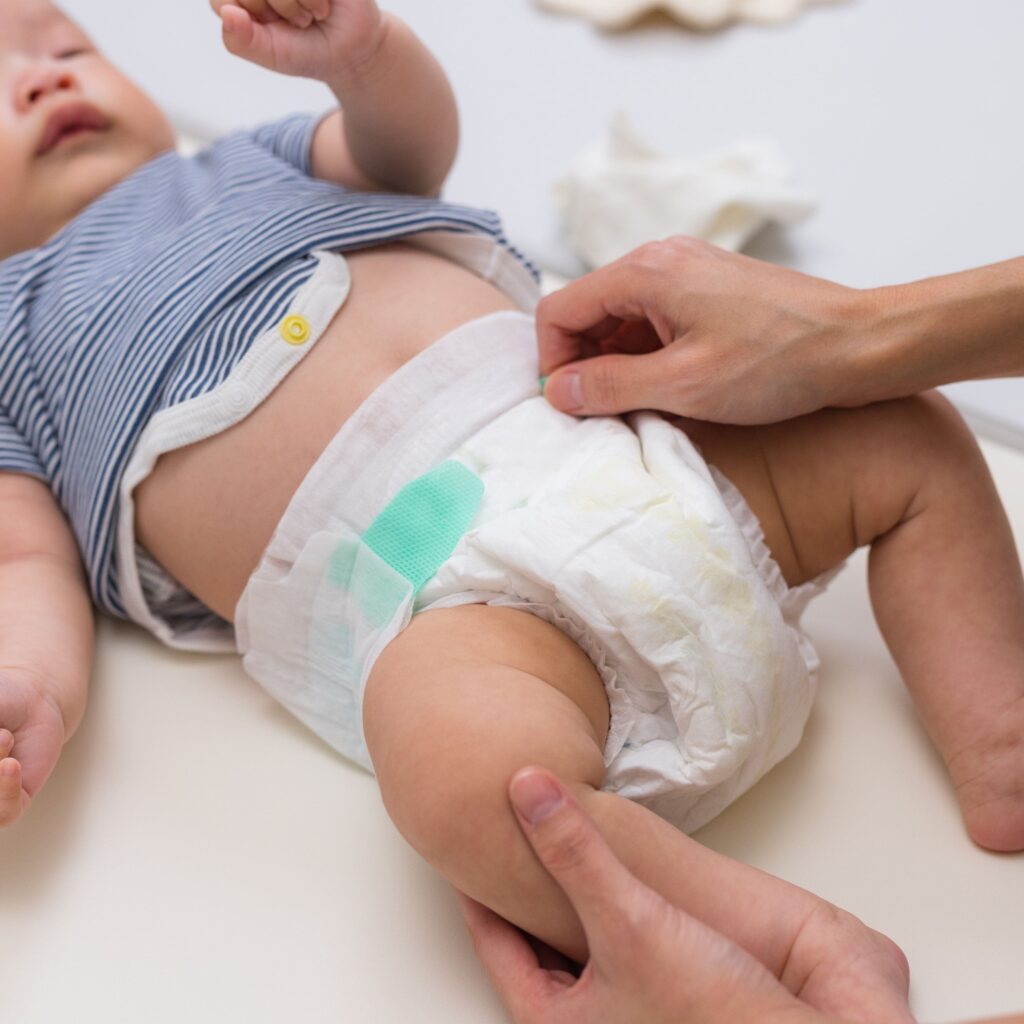
is Huggies or Pampers less toxic?
In terms of being less toxic, Huggies has stated all of their diapers are free of fragrances, phthalates, parabens, and elemental chlorine. They’ve also partnered with Terracycle to offer plastic film recycling options.
Pampers diapers are made without parabens, natural rubber latex and elemental chlorine. But only their Pure diapers are made without fragrance (and many mothers online have complained of Pampers’ strong scent).
However, Pampers’ factories are zero manufacturing waste to landfill and they use FSC certified wood pulp.
Both brands list their ingredients on their websites, so definitely read them for yourself before making a purchase. Just be mindful both brands also use colorants and printing inks to make designs and/or color change technology.
which diaper brands are safe for babies?
The diaper brands safe for babies are listed below. There’s a mix of disposable and cloth diapers, so there’s something for everyone.
However, be mindful that every baby is different and what works for one, doesn’t always work for another. For example, certain brands may fit your baby like a glove, whereas others may be too big: It’s all about experimenting and finding what works for your baby.
You can use this list as a starting point to help you choose a better, safer choice for your child. None of the brands listed here use fragrance, parabens, or other harsh chemicals.
I’ve gone ahead and highlighted some of my favorite features of each brand, but it isn’t an exhaustive list. Be sure to check out their websites for more information.
Also, if you cloth diaper, don’t forget to consider eco-friendly baby detergent brands because you’ll be doing a bit more laundry!
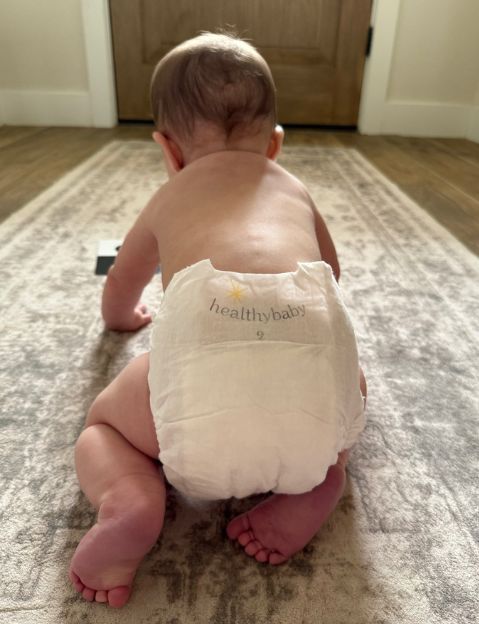
1. healthy baby
- Offers disposable and cloth diapering options
- Six sizes, not including newborn (N or N/1)
- Plant-based materials including organic cotton + FSC certified pulp
- 12 hour leak protection
- No chemical wetness indicator
- EWG certified
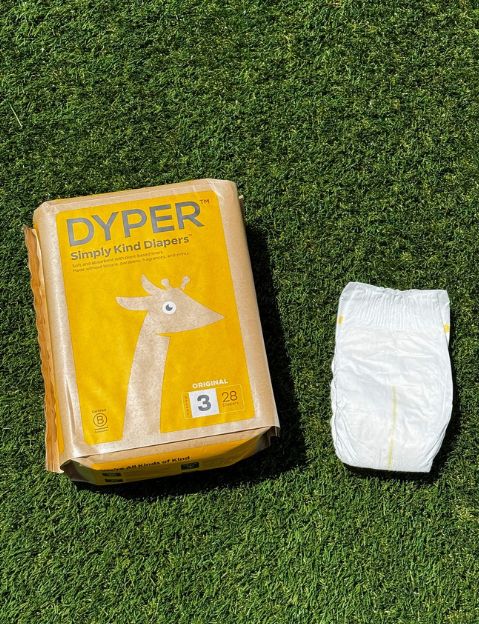
2. dyper
- Disposable diapers
- Six sizes, not including newborn (NB)
- Plant-based materials, including FSC-certified pulp
- 12-hour leak protection
- No inks, prints or dyes
- Offers REDYPER service to compost diapers through weekly pickup
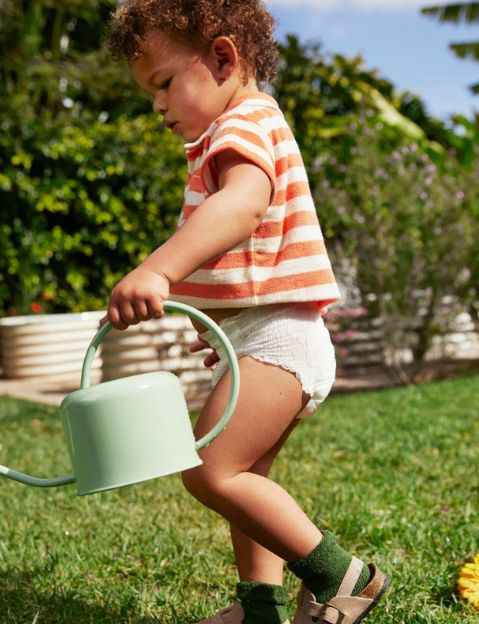
3. coterie
- Disposable diapers
- Seven sizes, not including newborn (N or N+1)
- 25% plant-based, made with wood pulp from sustainably manages forests
- 12-hour leak protection
- Wetness indicator
- Cruelty-free
- OEKO-TEX STANDARD 100 Certified

4. esembly baby
- Cloth diapers
- Two sizes, based on pounds
- Made of organic cotton + upcycled TPU
- Recommended to change an awake baby every 2-3 hours
- Wet bags sold separately to hold dirty diapers while out
- Pre-loved options to buy and sell available
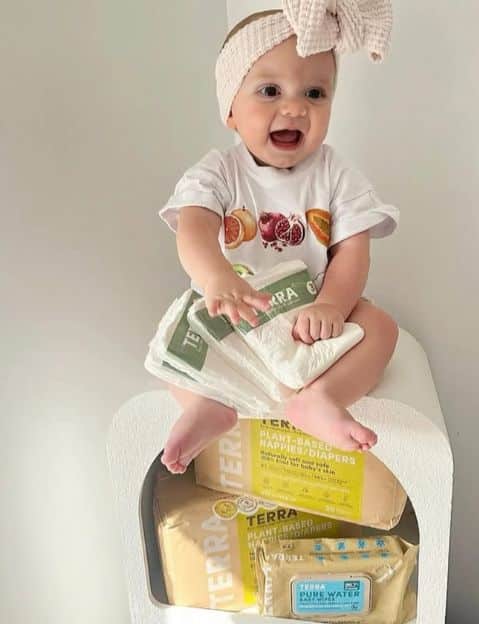
5. terra
- Disposable diapers
- Six sizes
- 85% plant-based, including FSC-certified pulp
- 12-hour leak-proof protection
- Plant-based wetness indicator
- Ink on product + packaging is food grade
- Packaging is made from recyclable kraft paper + rice

6. freestyle
- Disposable diapers
- Six sizes
- 7-layer protection for 14x better absorption
- Delivered in 1 month long supplies
- FSC certified pulp
- EWG verified
Which of these sustainable diaper options would you choose? Let me know in the comments!
The post 6 Best Non Toxic Diapers For Babies appeared first on Going Zero Waste.
Green Living
The Many Layers of Personal Style
Personal style is a dance between dualities: fashion as art and fashion as function; clothing as self-expression and clothing for our circumstances.
Style is a medium for communication and self-expression, yes. But it’s also shaped by the environments and requirements around us, from workplace dress codes to city cultures, climates, and specific occassions.
In last Saturday’s workshop, where we talked about how to remix what you already have in your closet, attendees shared a common challenge:
How do you balance your personal style expression while dressing for the various situations and environments we operate in?
“I’ve found above all else my style is highly influenced by my environment (my job, my city etc.)—sometimes it becomes about ‘fitting in’ and losing individuality”
“I find I’m too led by my day-to-day lifestyle. I WFH and so often I just don’t get dressed at all.”
“There are too many applications: workout, work, at home, formal occasion.”
Style as Identity vs. Style as Communication
It’s no wonder style and getting dressed can feel so confusing.
In the personal style world, we learn to dress for who we are on the inside. And then we see the style rules in fashion media: here’s how to dress for this season, this dress code, this city.
And in our real lives, we have real dress codes we might have to follow, whether for a workplace or a wedding.
But what if all those sides conflict?
- If my style words are “casual” or “sporty” but I’m in a workplace 40+ hours a week that requires business formal, where does that leave my personal style?
- If I love vibrant and artsy looks, but I live in a city full of neutrals, what do I wear?
It’s no surprise it feels… complicated.
Here’s my take.
We’re Not One-Dimensional — Neither is Our Style
Sometimes I want to disconnect and live in cottage in the mountains, surrounded by more trees than people. Other days I dream of having an apartment in the center of Paris where I see more people in a day than live in my hometown.
I’m light, joyful, maybe even quirky with friends. I’m ambitious, intentional, perhaps more serious in work. There are times I feel it’s best to soften and let it go; other times it feels most aligned to be unapologetically outspoken.
We are human. We’re social creatures. We’re complex and full of contradictions.
Social media has trained us to fit people into neat boxes because “niche” is what performs in the algorithm.
In real life, though, our “authentic” selves aren’t so one-dimensional.
I’m not speaking to new networking contacts the same exact way I talk to my best friend I’ve known for years. That doesn’t mean I’m pretending to be someone else. It just means I’m showing up a bit differently depending on the context.
Similarly, our personal style doesn’t have to be expressed in one singular way.
That’s what’s beautiful about fashion! We have the opportunity to express ourselves a bit differently each and every time we get dressed.
What we wear might ebb and flow with a situation, the season, or our mood. There are common threads, but differentiators too.
Three distinctly different looks can all be authentic.
For me, personal style isn’t about being setting such rigid parameters that we can no longer embrace our multi-dimensional nature.
And there’s undoubtedly the layers of privilege at work here too. Is it safe to dress in alignment with your true identity in that particular situation? Will you be taken seriously? Could there be repercussions?
There’s a lot to untangle when it comes to what we wear.
Making Our Multi-Dimensional Style Practical
As I shared in last week’s workshops, style is many layers. The four I see it through are the vibe, the shapes, the colors & textures, and our lifestyle & values.

The aesthetic reflects your vibe, mood or style adjectives.
- For example, my vibe or adjectives are feminine, structured, grounded.
The shapes are the fits, silhouettes, and proportions you love.
- I often wear outfits with a straight silhouette or tailored fit balanced with a relaxed, flowy, or drapey element.
Colors & textures include your preferred palettes, fabrics, and the way materials feel.
- I prefer wearing natural fibers when possible. I like gold jewelry, and I feel more aligned in lower contrast looks. Lighter colors for day. Sometimes darker for evening or certain events.
The lifestyle & values element is the consideration of your actual day-to-day. What situations and environments are you dressing for? What is important to you?
- I work from home so comfort is key most of the time. I value slow fashion practices — rewearing, repairing, and supporting circular practices and sustainably-minded brands.
Once you understand these layers of your style, the next step is figuring out how to apply them in real-life situations.
Applying Your Style to the Situation
In last week’s workshops, I talked about the role of outfit templates here for various situations. What is the foundational blueprint of what you might wear to your office, working from home, in a school setting, at home, running errands, and so on?
There are opportunities to bring in the layers of your personal style in these various situations, but it does require some intentionally on the outset. Otherwise, it’s easy to fall into our old patterns or copy what others around us wear. (Even subconsciously, as fashion psychologist Shakaila Forbes-Bell has shared!)

Here’s one of my work-from-home outfit templates that balances style and situational needs:
- Blouse with feminine detail: I start with the top for Zoom calls!
- Straight-leg bottoms: this could be jeans, colorful pants, or a column skirt
- Slim shoes: the general “slim” descriptor makes it versatile across seasons
- Structured bag: an option to add polish when coworking at a café
By thinking in these various layers (vibe, shapes, colors & textures, and lifestyle & values) you can build outfits that feel authentic to you while fitting the constraints of the external situation.
What About One-Off Unique Situations?
Like this Wednesday evening, I spoke on a “Sustainable Fashion in Action” panel with Chicago Climate Connect during Sustainable Fashion Week Chicago. But the panel was also taking place at the Patagonia x Worn Wear store.
So the vibe was professional meets fashion, but also kinda casual?! And we are still in the Midwest here. I have to say, this one wasn’t easy.
But here’s the step-by-step thought process that helped me balance my style, function, and a unique-to-me context.

- I picked a foundational piece: My navy wide-leg trousers were business casual without being too formal and were practical for train travel.
- And functional accessories:My old Coach bag fits everything and my chunky Veja sneakers matched the vibe I was going for so those were the picks.
- Then a piece that brought it all together:At this point I was mixing high-contrast colors (white with navy & black) and different vibes (trousers vs. sneakers). I felt like I needed a bridge for the outfit, and this navy-striped vest tied it all together.
- Finally, some final touches: Gold jewelry made the look feel more “me”, while this cap from Abbie at The Filtery made it all feel effortless.
In the end, this outfit took a lot longer to create than a typical look.
It took longer to create than my usual outfits, but it felt just right. The combination was practical, suited my style, fit the vibe of the panel, and aligned with the weather.

This panel outfit reminded me that style is what we wear to express ourselves, but it’s also a tool to help us navigate our lives. By thinking through these layers of personal style (vibe, shapes, colors, textures, and lifestyle needs) we can balance showing up authentically while honoring the nuances or navigating the constraints of a situation.
For me, that’s the real power of personal style.
One single outfit can’t tell the whole story of who we are. But personal style can be flexible, functional, and expressive of the many sides of our multi-dimensional nature.
So lately, more than asking “does this outfit perfectly express my full self?” I’ve been finding myself asking:
“Does this outfit help me show up in the way I want to? Does it say what I want it to say in this particular moment?“
The post The Many Layers of Personal Style appeared first on .
-
Climate Change2 years ago
Spanish-language misinformation on renewable energy spreads online, report shows
-
Climate Change3 months ago
Guest post: Why China is still building new coal – and when it might stop
-
Greenhouse Gases3 months ago
Guest post: Why China is still building new coal – and when it might stop
-
Climate Change Videos2 years ago
The toxic gas flares fuelling Nigeria’s climate change – BBC News
-

 Greenhouse Gases1 year ago
Greenhouse Gases1 year ago嘉宾来稿:满足中国增长的用电需求 光伏加储能“比新建煤电更实惠”
-

 Climate Change1 year ago
Climate Change1 year ago嘉宾来稿:满足中国增长的用电需求 光伏加储能“比新建煤电更实惠”
-

 Carbon Footprint2 years ago
Carbon Footprint2 years agoUS SEC’s Climate Disclosure Rules Spur Renewed Interest in Carbon Credits
-
Renewable Energy4 months ago
US Grid Strain, Possible Allete Sale


